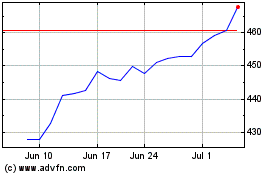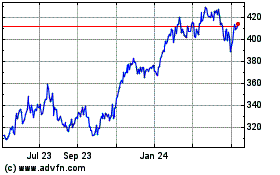Its iconic business loses organizational clout as cloud
computing takes hold
By Jay Greene
This article is being republished as part of our daily
reproduction of WSJ.com articles that also appeared in the U.S.
print edition of The Wall Street Journal (March 30, 2018).
Microsoft Corp. is downgrading the role of Windows, the storied
franchise that put the company atop the personal-computer market at
a time when cloud computing didn't exist.
Now, amid the massive shift in the way computing power is
harnessed, the software giant will reorganize its business around
its growing Azure cloud-computing operations and its stalwart
Office productivity business.
Executive Vice President Terry Myerson, who ran the Windows
business, will leave the company, according to an internal email
from Microsoft Chief Executive Satya Nadella on Thursday.
The move is designed to focus Microsoft on its biggest areas of
growth. In its latest quarter Azure revenue jumped 98% while Office
365 grew 41%, though the company doesn't give totals for those
segments. In the same period, the More Personal Computing unit,
which includes Windows, gained 2% to $12.17 billion.
"Having a deep sense of customers' unmet and unarticulated needs
must drive our innovation," Mr. Nadella said in the email he sent
to employees Thursday morning. "We can't let any organizational
boundaries get in the way of innovation for our customers. This is
why a growth-mindset culture matters."
Microsoft declined to make executives available for comment.
In a post on Microsoft's LinkedIn page, Mr. Myerson, who has run
the Windows business since 2013, said the day was an "emotional"
one for him but expressed his "ongoing enthusiasm for
Microsoft."
For most of its 43 years, Microsoft and Windows have been nearly
synonymous. Under Mr. Nadella's predecessor, Steve Ballmer,
products were sometimes stalled, or even killed, because they
didn't help expand the market for the operating system.
That Mr. Nadella is willing to shift the company's focus away
from Windows illustrates the irreversible migration from personal
computing to mobile devices and the web. It also shows how Mr.
Nadella is putting his own imprint on the tech giant.
"He's clearly not handcuffed by history," said Stifel Nicolaus
& Co. analyst Brad Reback.
Mr. Nadella is able to break from the past because, during his
four years as chief executive, Microsoft has emerged as a leader in
cloud computing. Its Azure operations is No. 2 behind Amazon.com in
the cloud-infrastructure market. And its Office 365 productivity
apps and its Dynamics business-software services are rapidly
growing, multibillion-dollar businesses.
"The Microsoft of old could never have made this move," Mr.
Reback said. "But the pieces were not in place to make the
move."
Mr. Myerson, a 21-year Microsoft veteran, will leave the company
and help with the transition "over the coming months," Mr. Nadella
wrote.
The company is breaking Windows in pieces. The platform
technology, on which Microsoft's partners build their own devices,
apps and services, will now fall under Scott Guthrie, who runs the
Azure business. Mr. Guthrie's unit, called Cloud + AI Platform,
will also include the company's mixed-reality business, including
Microsoft's Hololens device, as well as its artificial-intelligence
business.
Microsoft's devices business, including its Surface lineup of
computers, will fall to Rajesh Jha, who has been in charge of
Microsoft's Office group. The new, bigger unit, called Experiences
& Devices, will also include Microsoft's efforts to develop new
features in Windows.
In his note, Mr. Nadella called the future of Windows "bright,"
as the company pushes to develop features that take advantage of
new types of devices and emerging technologies such as artificial
intelligence. Nearly 700 million devices run Windows 10, the
software's latest version. All told, some version of Windows is on
more than 1.5 billion devices world-wide. In the most recent
quarter, the More Personal Computing unit accounted for 42% of
Microsoft's revenue.
"This is the most sweeping reorg that I can recall," said Brad
Silverberg, who ran the Windows division when Microsoft launched
its seminal Windows 95 operating system.
In the 1990s, Windows was so dominant that a federal judge ruled
that it was a monopoly. The U.S. Department of Justice sought to
break up Microsoft, accusing the company of abusing its dominance
in the PC operating system market to crush rivals. The company
ultimately signed a consent decree in 2002, agreeing, in part, to
make Windows interoperable with non-Microsoft software.
While Microsoft is still focused on building the platform upon
which other tech companies run their technology, that focus is now
on Azure, said Mr. Silverberg, a venture capitalist who co-founded
Fuel Capital, a San Francisco-based firm. He praised Mr. Nadella's
acknowledgment of Windows' reduced importance.
"He recognizes the world for what it is, not what it used to
be," Mr. Silverberg said.
Write to Jay Greene at Jay.Greene@wsj.com
(END) Dow Jones Newswires
March 30, 2018 02:47 ET (06:47 GMT)
Copyright (c) 2018 Dow Jones & Company, Inc.
Microsoft (NASDAQ:MSFT)
Historical Stock Chart
From Mar 2024 to Apr 2024

Microsoft (NASDAQ:MSFT)
Historical Stock Chart
From Apr 2023 to Apr 2024
